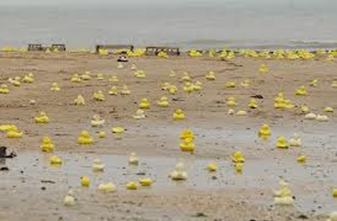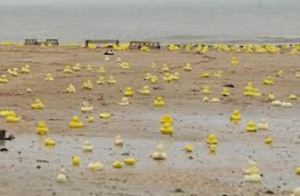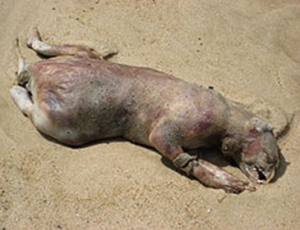Cryptic Corner: What’s Coming Ashore?

We’ve all gone to the beach and seen what washes up on the sand: shells, seaweed, or the occasional chip bag. But what if you went to the seashore and found something you would never expect to find? See below for some interesting things that have washed ashore on beaches across the world.
Rubber ducks
In 1992, a large shipment of rubber ducks fell overboard from a cargo ship in the middle of the Pacific Ocean. For years, 28,000 of these classic bath-time companions have been floating throughout the sea and onto various beaches in Australia, Scotland, Hawaii, Alaska, and South America. Some have even been found frozen in Arctic ice!
Random shoes
On more than one visit to the ocean, I’ve seen a shoe bobbing in the waves. But never have I seen a shoe that still had a foot in it! Since 2007, people have discovered at least ten severed feet, still wearing shoes, in the Pacific Northwest and British Columbia. No one is sure where these body parts are coming from or why they are washing up on beaches.
Bunches of bananas
Any hardcore Doctor Who fan should remember this funny quote from the lovable time-traveling character “the 9th Doctor” who was explaining why he was carrying around a random banana: “I like bananas. Bananas are good.”
I’m sure, then, that the 9th Doctor would love to visit the Dutch North islands, where thousands of bunches of bananas found their way onto the beach in 2007. Just like the rubber ducks, the fruit had fallen off a cargo ship. This kind of thing is normal for the island dwellers – multiple cargo shipments have washed up on their beaches including sweaters, shoes, and children’s toys.
Monsters
Most people don’t believe in monsters, but they might change their minds after they read this. In July of 2008, a creature was found on the beach in Montauk, New York. There were rumors that the creature, later called the “Montauk Monster,” might have been an escaped experimental animal from the nation’s only Animal Disease Center on nearby Plum Island, where scientists and researchers employed by Homeland Security work on high-consequence foreign animal diseases.
Health officials eventually claimed that the creature was a bloated, decomposing raccoon. But if this is the case, why had it lost all its fur? Why do its back legs look deformed? Why does the creature have a piece of fabric tied around one of its legs? Could the bloated raccoon actually be something else?
My dear readers, who knows what’s going to wash up next, so keep your eyes open for shipwrecked bath toys, bananas, or body parts.






